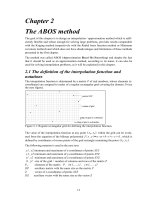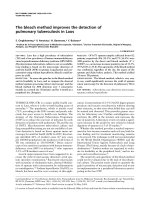The audiolingual method quiz
Bạn đang xem bản rút gọn của tài liệu. Xem và tải ngay bản đầy đủ của tài liệu tại đây (56.64 KB, 4 trang )
METHODOLOGY 1 – October 31, 2006.
Check your understanding about The Audioligual Method
Student’s name: ……………………………………………………..
The Audiolingual Method focuses on: (check the correct answers)
1. automatic language habit formation
2. structure of the target language
3. written language
4. explicit grammar
5. imitation and repetition with drills
6. fluency
7. first language instruction
8. reinforcement (Teacher’s comment on students’ work)
9. everyday speech
10. students’ creativity in making speech
11. dialog memorization
12. pronunciation
13. error correction
14. student’s inner competence
METHODOLOGY 1 – October 31, 2006.
Check your understanding about The Audioligual Method
Student’s name: ……………………………………………………..
The Audiolingual Method focuses on: (check the correct answers)
1. automatic language habit formation
2. structure of the target language
3. written language
4. explicit grammar
5. imitation and repetition with drills
6. fluency
7. first language instruction
8. reinforcement (Teacher’s comment on students’ work)
9. everyday speech
10. students’ creativity in making speech
11. dialog memorization
12. pronunciation
13. error correction
14. student’s inner competence
METHODOLOGY 1 – October 31, 2006.
Check your understanding about The Audioligual Method
Student’s name: ……………………………………………………..
The Audiolingual Method focuses on: (check the correct answers)
1. automatic language habit formation
2. structure of the target language
3. written language
4. explicit grammar
5. imitation and repetition with drills
6. fluency
7. first language instruction
8. reinforcement (Teacher’s comment on students’ work)
9. everyday speech
10. students’ creativity in making speech
11. dialog memorization
12. pronunciation
13. error correction
14. student’s inner competence
METHODOLOGY 1
THE AUDIO-LINGUAL METHOD
Exercise 1: Which of the following statements describe the Audio-lingual Method? Which does
not? Circle your choice.
1. Dialogs are useful way to introduce new material.
2. Students’ native language should be kept apart so that it interferes as little as possible
with their acquisition of the target language.
3. Students need to memorize grammar rules in order to use the language.
4. It is important to prevent learners from making errors.
5. Positive reinforcement helps students to develop correct habit in the target language.
6. Vocabulary is important and should be taught before structural patterns.
7. Students can initiate their own interactions in some stages of the lessons.
8. Speech is more basic to language than the written form.
9.
The learning of a foreign language should be the same as the acquisition of the native
language.
10. Teachers direct and controll all the language behaviors of the students.
METHODOLOGY 1
THE AUDIO-LINGUAL METHOD
Exercise 1: Which of the following statements describe the Audio-lingual Method? Which does
not? Circle your choice.
1. Dialogs are useful way to introduce new material.
2. Students’ native language should be kept apart so that it interferes as little as possible
with their acquisition of the target language.
3. Students need to memorize grammar rules in order to use the language.
4. It is important to prevent learners from making errors.
5. Positive reinforcement helps students to develop correct habit in the target language.
6. Vocabulary is important and should be taught before structural patterns.
7. Students can initiate their own interactions in some stages of the lessons.
8. Speech is more basic to language than the written form.
9.
The learning of a foreign language should be the same as the acquisition of the native
language.
10. Teachers direct and controll all the language behaviors of the students.
Exercise 2: These are some key terms related to the description of the Audio-lingual Method.
Complete the sentences below using one of the key terms given.
overlearn
1. To be able to communicate, students need to ……………………… the
target language, to learn to use it automatically without stopping to think.
habit formation
2. Teachers can use spoken or picture ……………………… to stimulate
students practice the target language.
imitator
explicit grammar
3. Students are …………………. of the teacher’s model or the tapes s/he
supplies of model speakers.
contextualize
4. Grammatical points are taught from the examples and drills, so
…………………. rules are not provided.
minimal pair
5. Because language acquisition results from …………………, students
need lots of drills to overcome the old habits of their native language.
structural pattern
6. Cultural information and vocabulary are …………………….. in the
dialogs.
cue
7. After the teacher does the contrastive analysis, she asks students
discriminate similar sounds using ……………………..
8. The syllabus typically consists of ………………… included in the new
dialog.
Exercise 2: These are some key terms related to the description of the Audio-lingual Method.
Complete the sentences below using one of the key terms given.
overlearn
1. To be able to communicate, students need to ……………………… the
target language, to learn to use it automatically without stopping to think.
habit formation
2. Teachers can use spoken or picture ……………………… to stimulate
students practice the target language.
imitator
explicit grammar
3. Students are …………………. of the teacher’s model or the tapes s/he
supplies of model speakers.
contextualize
4. Grammatical points are taught from the examples and drills, so
…………………. rules are not provided.
minimal pair
5. Because language acquisition results from …………………, students
need lots of drills to overcome the old habits of their native language.
structural pattern
6. Cultural information and vocabulary are …………………….. in the
dialogs.
cue
7. After the teacher does the contrastive analysis, she asks students
discriminate similar sounds using ……………………..
8. The syllabus typically consists of ………………… included in the new
dialog.









